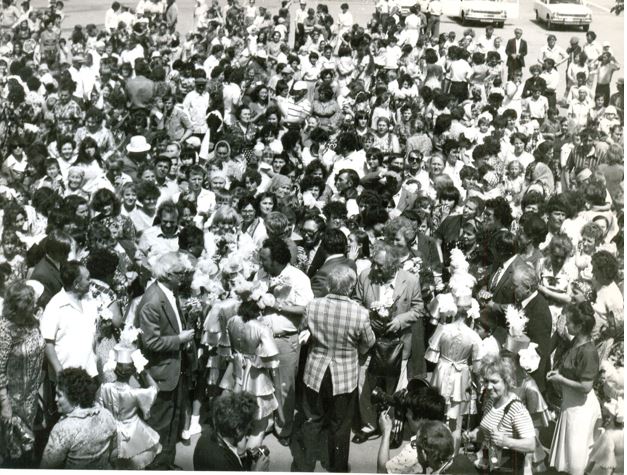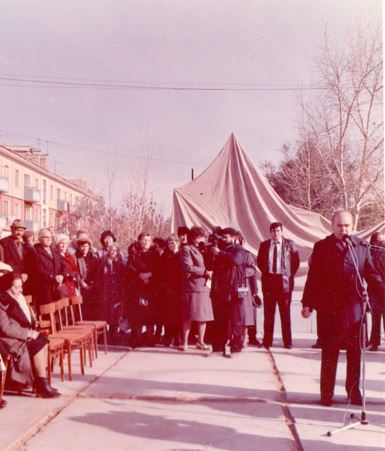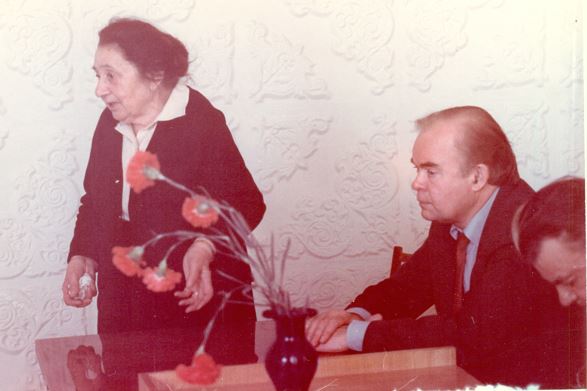In 1989, the complex "Memorial" was created in Malinovka in the memory of the victims of repression [1]. On how the complex was opened I.I. Sharf writes: "One of our initiative - the creation of a monument to victims of political repression. We gathered and with general meeting began to decide what to do to preserve the memory of women who experienced the effects of Stalin's repressions. It was decided to build mounds on the place of burial. It was hard to find this place, classified information. The Gorkovy family of doctors helped us. Especially their son Fedor. They suggested” [2].
Meeting of the Alzhir prisoners. Akmol, 1989
About Ivan Ivanovich Sharf is written in the book of "the prisoners of Algeria", published with the support of the International Society "Memorial" in Moscow: "In Malinovka, so now called former labor village №26 - a monument to the prisoners of Algeria stands. On poplar avenue, planted once with their hands, benches with the names and fragments of memories are installed, in the House of culture, the museum of Alzhir is created. On the place where the dead prisoners were buried, the symbolic Christian and Muslim tombstones were settled. We cannot mention that all of this- the monument, the stands, the museum, and memorial tombstones are established and operate under support of the JSC “Akmola-Fenix” Director General I.I. Sharf. The monument was erected in 1989, when there was no serious speech about it in many regions of the USSR". [3]
I.I. Sharf at the meeting of the Alzhir prisoners. Akmol, 1989
In 1989 in the village center of Malinovka he settled the monument - chopped red star, surrounded by barbed wire which according to I.N.Yurashevich architect's plan symbolizes torn human soul. I.I. Sharf recalls this: "Alley of tears, the one that planted the prisoners of Algeria, was made a museum under the open sky and called the Alley of victims of political repressions. The first meeting of former prisoners and their children was held on October 18, 1989, the opening day of the memorial "ALZHIR". They were little. Twenty-gray-haired women, whose age is far beyond 70. We provided transportation, food, accommodation, presented souvenirs. People were surprised how it was possible in Soviet times, worried that we might be punished. But that was more pleasant thanks" [2, 80].
A.Tasymbekov recalls: "In 1990, in Malinovka by the decision of the movement "Adilet" - "Memorial", and at the request of the people, the monument to the honor of the mothers who died during Stalin's repressions in Alzhir was erected. It should be noted that the initiators and the supporters were the heads of Akmola poultry farm. We gathered all the remaining mothers from all over the Soviet Union" [4].
At the meeting were S.K. Tashtitova, V. Mayzholova-Kulenova, K.I. Maltseva, A.G. Endanova, T.P. Afonina, M.I. Krut'ko, E.F. Vereshchagina, also the prisoners' children I.V. Shubrikova, I.E. Shadrina, E.B. Tovarovskaya, O.G. Golubev, E.N. Koracio, E.N. Shafarenko, G.S. Rachkova. Children of the prisoners opened a memorial sign. At the rally, I.I. Sharf said: "This tragedy should never happen again!"
Tashtitova Sagadat with flowers. Akmol, 1989
Former prisoners of Alzhir spoke at the meeting about the life behind barbed wire: Tashtitova Sagadat Kudabaevna: "I came to this meeting from Alma-Ata. I cannot believe I'm standing here on the place of former 26th point. My husband was shot in 1937, and I was sent to the camp. I was 22 years old. Of course, for us it was very hard, but the women were kept bravely. We lived together and didn’t divide each other by nationalities. Many, unable to withstand the harsh life, died. They were buried in large pits, putting a sign with the name, date of birth and the arrest. Those that died were taken away at night and one morning, going to work, we saw a dead body on the road - the driver lost it in the dark".
Kulenova V. looks at T. Vereshchagina’s embroidery. Akmol, 1989
Mayzholova-Kulenova Vazifa: "In August 1936, a few months after my husband's arrest, they came after me. My three-year-old daughter was sent to children's home, and I - here, to the camp. I worked here in a sewing factory until 1946. During the war, we sewed jackets and tunics for our soldiers. We worked without complain of our hands and eyesight". Maltseva Kaleria Ivanovna: "We dug ditches and planted poplar trees along them. The ditches fed fields in which women grew vegetables and potatoes. During the war, they were sent to hospitals in Akmola. Exhausted from the heat, the vegetables harvested for future use on the dryer". Endanova Anna Grigoryevna: "I worked as a cook in the camp, food was scarce. They supply us with lamb's head, peeled barley and peas. My piece of bread I gave to the women, who worked on the workpiece cane. They were very hungry". [5]
At the rally, Valentina Savelevna Shevchenko, daughter of Alzhir prisoner Mariam Lazarevna, who came to the meeting instead of her mother, read poems:
We tempered clay, dried adobe,
And built a club behind zone.
Such proportion dropped us,
Conviction for that – we were wives.
Legs were shaking and aching back,
But we completed the deal,
And near – there was an artist, also wife,
She wrote red and white,
Finished and wiped the sweat,
Slogan was shot up skyward:
"Thank you Comrade Stalin,
For our happy life!"
Broken red star, surrounded by barbed wire, the author of which was the famous architect N.N. Yurashevich, symbolized the torn human soul. According to Ivan Ivanovich Sharf, the monument was made for three days. It was installed on the night before the opening. Broken red star became a symbol and the history of Malinovka. Until now, it stands in the center of the village as a reminder of past years. [5]
Author of the project Nikolay Yurashevich long time worked with Ivan Sharf, he was invited in Malinovka in the early 80s. Now he is a well-known architect of Kazakhstan.
Director of the Museum of Political Repression Zhaksybayeva R., Director General of JSC "Akmola Fenix" I.I. Sharf, researchers from the University of Bonn - Vladislav Hedeler and Meinhard Stark
At this meeting the chief of Alzhir M.T. Yuzipenko was invited. In the years 1940-1941 he was the head of a special department of the Akmola KarLag, in 1941-1943 years, deputy chief of the above, i.e. Akmola women’s camp of «traitors». [6] According to the head of the "History of the camp Alzhir" museum R. Zhaksybayeva, the majority of captive women came to the meeting. They openly showed their hostility to M. Yuzipenko, participated in the meeting.
By Arailym MUSAGALIYEVA
d.h.s., professor of ENU named after L.N. Gumilev
Photos from the archive of JSC “Akmola Fenix”, Akmol, Tselinograd region, Akmola oblast
Sources used:
1. The State Archives of the Akmola region, f.2647, d.60, l.38
2. Malinov milestones. Collection of publications and memories (from Algeria to modern Malinovka). Malinovka - Astana, 2003.- 82 p. - P.79
3. The prisoners of "Algeria". List of women - prisoners of Akmola and other departments of KarLag. Moscow, "Links", 2003.- 567 p. - P.30
4. Tasymbekov A. Jan dauysy: ALGERIA archipelag. Almaty, 1994, -. P.47
5. Smagulova G. Finding memory // Call. - May 31, 1989
6. The State archive of Astana (hereinafter - SAA), p. 370, op.1, d.50, ll.1-6






